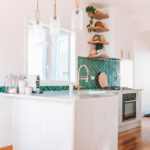Slate is a natural stone known for its durability and attractive appearance. It comes in a variety of colours and textures, making it a popular choice for flooring among homeowners who want to find a style that suits their preferences and interior design themes.
As homeowners, we want to make sure our slate floors stay clean and beautiful. With their natural texture and porous surface, slate floors can trap dirt and stains if not cleaned properly.
In this article, we’ll teach you not just how to clean your slate floors, but also how to keep them pristine and shiny.
7 Steps To Cleaning Slate Floors
In just seven simple steps, you can have your floor looking brand new. Let’s walk through the process step by step.
1. Sweep the floor with a soft-bristle broom or use a vacuum cleaner with a brush attachment to remove loose dirt and debris. Ensure you get into the corners and along baseboards.
2. Mix your chosen slate cleaner with warm water in a bucket, following the manufacturer’s instructions. Avoid using acidic or abrasive cleaners, as they can damage the slate.
3. Before cleaning the entire floor, test the cleaning solution in a small, inconspicuous area to check for any adverse reactions.
4. Dip a soft-bristle brush or a mop into the cleaning solution and scrub the slate floor gently. Ensure to cover the entire floor surface. Focus on any stained or dirty areas and work in small sections.
5. After scrubbing, use a mop or a clean cloth dipped in plain water to rinse off any detergent residue. Change the water regularly to prevent spreading dirt back onto the floor.
6. Use a soft, clean towel or a dry mop to remove excess water from the floor. Prevent water from sitting on the slate, as it can lead to water spots or damage.
7. If desired, apply a stone sealer to protect the slate and enhance its appearance. Follow the manufacturer’s instructions for application and drying time.
To keep your slate floor clean, make sure to do regular maintenance. Sweep or vacuum the floor regularly. If spills occur, you should wipe them up promptly.

Remove Loose Dirt
The first step to achieving clean slate tiles is to remove loose dirt. To do this, you can use a soft-bristle broom or a vacuum cleaner with a brush attachment. This will help prevent any scratches or damage to the surface of the slate tiles.
Start at one end of the room and slowly work your way towards the other side, making sure to reach into the corners and along the baseboards.
Take your time and be thorough in sweeping or vacuuming to ensure that all the loose dirt and debris is completely removed.
Prepare Your Chosen Cleaning Solution
After sweeping all loose dirt, the next step is to choose and prepare your cleaning solution. It’s important that you choose proper cleaning solutions that won’t cause any harm to your slate tiles.
Here are some recommended cleaning solutions you can try:
1. Mild detergent: Prepare a solution by mixing a mild cleaning detergent with water. Follow the instructions on the detergent bottle for proper dilution. Ensure the solution is well-mixed before using it to clean the stain.
2. Hydrogen peroxide: Create a solution by combining equal parts water and hydrogen peroxide. Mix them together thoroughly to ensure even distribution. This solution is now ready to be applied to the stain.
3. Rubbing alcohol: Mix rubbing alcohol with water in a 1:4 ratio (one part rubbing alcohol, four parts water). Stir well to combine the two ingredients. Make sure the solution is well-mixed before using it to tackle the stain.
4. Baking soda paste: Make a paste by mixing baking soda with water until it forms a thick consistency. Add small amounts of water at a time to reach the desired paste-like texture. Adjust the ratio as needed to achieve the desired consistency.
5. Commercial slate cleaner: Follow the manufacturer’s instructions on the specific commercial slate cleaner you are using. Generally, you will dilute the cleaner with water according to the instructions provided. Mix the solution well to ensure proper dilution.
Important! Avoid using abrasive cleaners that could harm the surface. Instead, opt for a pH-neutral cleaner specifically made for slate floors if your floor is sealed.
Test in a Small Area
Testing the cleaning solution in a small area is an important step before cleaning your entire slate floor. Different types of slate tiles may react differently to cleaning agents, so it’s crucial to check for any adverse reactions first.
To perform the test, choose a small, inconspicuous area, like a corner or a spot under furniture. Apply a small amount of the cleaning solution and let it sit for a few minutes. Then, wipe it off with a clean cloth.
While observing the test area, pay attention to any changes in colour, texture, or shine. If there are no adverse reactions, you can proceed confidently to clean the rest of the floor.
However, if you notice any discolouration or damage, choose a different cleaning solution or seek professional help.
Start Scrubbing and Mopping the Floor
Once everything’s ready, grab a soft-bristle brush or a mop and prepare for a session of mopping and scrubbing slate floors.
Dip your brush or mop into the cleaning solution and gently scrub the entire floor surface. Take your time and cover every area, paying extra attention to any stained or dirty spots. It’s a good idea to work in small sections to make sure you clean the floor thoroughly.
Once you’ve finished scrubbing, go over the floor with a clean, damp mop to ensure any remaining dirt or cleaning solution is removed. Allow the floor to air dry completely.
Remove Residue
Residue can make your slate floor look dull and dirty, so it’s important to get rid of it. To remove residue from your slate floor, you can use a clean, damp mop.
Start by filling a bucket with clean water. Dip the mop into the water, making sure it’s not too wet. Wring out any excess water and gently mop the floor, paying attention to areas with residue.
Remember to change the water regularly to avoid spreading dirt back onto the floor. Once you’re done mopping, let the floor air dry or use a clean, dry mop to remove any remaining moisture.
Dry the Floor
Start by using a clean, dry mop or a soft towel. This will help remove any remaining moisture from the surface.
Make sure your slate floor is clean and dry after mopping, as leaving excess water can cause water spots or damage over time.
Next, grab a soft-brushed broom and gently sweep the floor to get rid of any loose debris or dirt that might’ve accumulated during the cleaning process. This step will ensure that your floor is free of any unwanted particles.
Once the floor is debris-free, take a clean, dry mop or a soft towel and carefully go over the entire surface. Be sure to pay close attention to the corners and edges where water may tend to pool. This will help absorb any remaining moisture and leave your floor thoroughly dry.

Why You Should Seal Slate Floors
A slate floor sealant is a protective coating applied to a slate floor to enhance its appearance, provide a barrier against stains and moisture, and make it easier to clean and maintain.
Applying a sealer helps to prevent the penetration of liquids and dirt into the pores of the slate, reducing the chances of staining and damage.
Select the appropriate sealer for your specific slate type. There are various options available, including penetrating sealers and topical sealers, so choose the one that suits your needs. Follow the manufacturer’s instructions for application and drying time to achieve effective sealing.
Sealing your slate safeguards your slate floors against stains, spills, and everyday wear and tear. It also enhances the natural beauty of the slate, giving it a polished and finished look.
How Stone Protection Can Help You Keep Your Slate Floors Clean
If you don’t have the time to clean your slate floors, then don’t hesitate to leave the job to professionals. Professional restoration services companies like Stone Protection possess the expertise needed to revitalise your slate floors.
Stone Protection can also offer customised solutions for different types of slate, effectively removing stubborn stains or scratches that DIY solutions cannot simply fix.
Trust Stone Protection to deliver exceptional cleaning and maintenance solutions that will exceed your expectations. With our experienced team, cutting-edge techniques, and commitment to customer satisfaction, we guarantee we’ll leave you with a smile on your face.
Frequently Asked Questions
What should you not clean slate with?
You should not clean slate with acidic or abrasive cleaners, as they can damage the surface.
How do you rejuvenate slate floors?
To rejuvenate slate floors, you can deep clean them with a pH-neutral cleaner specifically designed for slate. You can also use a slate sealant to restore its shine and protect it from stains.
How do you make slate look new?
To make slate look new, you can start by cleaning it thoroughly with a slate cleaner and a sponge or soft-bristle brush. Once clean, you can apply a slate sealant or polish to enhance its colour and shine.
How do you care for natural slate floors?
It is recommended to regularly sweep or vacuum the surface to remove dirt and debris. You should also clean up spills immediately and avoid using harsh chemicals or abrasive cleaners. Applying a slate sealant periodically can help protect the surface and maintain its appearance.
Does wd40 clean slate?
WD40 is not recommended for cleaning slate as it is a petroleum-based product that can leave a residue on the surface and potentially dull its appearance.
What will make slate shine?
You can use a slate polish or sealant specifically designed for this purpose. Applying a thin coat and buffing it with a soft cloth can help bring out a high sheen on the slate surface.





